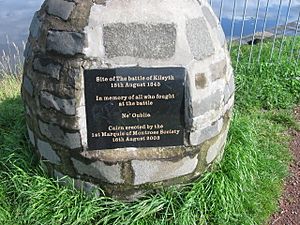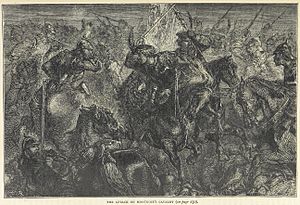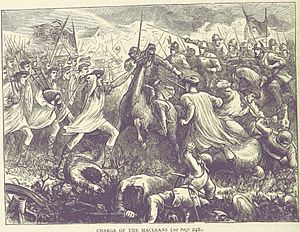Battle of Kilsyth facts for kids
Quick facts for kids Battle of Kilsyth |
|||||||
|---|---|---|---|---|---|---|---|
| Part of Wars of the Three Kingdoms | |||||||
 Cairn in memory of the Battle of Kilsyth |
|||||||
|
|||||||
| Belligerents | |||||||
| Commanders and leaders | |||||||
| Marquess of Montrose Alasdair MacColla |
William Baillie Alexander Lindsay, 2nd Lord Balcarres |
||||||
| Strength | |||||||
| 3,000 foot 500 cavalry |
7,000 foot 800 cavalry |
||||||
| Casualties and losses | |||||||
| Light | c.4,500 | ||||||
| Designated | 21 March 2011 | ||||||
| Reference no. | BTL13 | ||||||
The Battle of Kilsyth was a major fight during the Wars of the Three Kingdoms. This was a series of conflicts in the 1640s involving England, Scotland, and Ireland. The battle took place on August 15, 1645, near Kilsyth, Scotland. It was the biggest battle of the conflict in Scotland.
In this battle, the Royalist army, led by Montrose, won a big victory. They defeated the forces of the Scottish Parliament, who were known as the Covenanters. This battle ended General William Baillie's chase of Montrose's Royalist army.
Contents
Why the Battle Happened
Between 1644 and 1645, Montrose led a successful campaign across Scotland. His goal was to keep Scottish government troops busy. This would stop them from helping the Parliamentarian side in the First English Civil War. Montrose's army included a group from Confederate Ireland, led by Alasdair Mac Colla.
Montrose had already won several battles against the Covenanters. These included Tippermuir, Aberdeen, Inverlochy, Auldearn, and Alford. After a costly victory at Alford on July 2, 1645, only one main government army was left in Scotland. This army was led by the experienced soldier William Baillie.
Baillie's Army and Montrose's Plan
General Baillie and his army were in Perth. They were attending a meeting of the Scottish government, called the Estates. Baillie's army was a mix of new, untrained soldiers from Fife. It also had some regular regiments that had returned from England. Some soldiers were survivors from regiments Montrose had already beaten. His cavalry, led by Lord Balcarres, were mostly regular dragoons (soldiers who rode horses but fought on foot).
In addition, a noble called the Earl of Lanark was raising new troops. He had about 1,000 foot soldiers and 500 cavalry. These troops were on their way to join Baillie's main army.
When Montrose heard about Lanark's troops, he decided to act fast. He wanted to fight each group separately before they could join forces. Montrose marched his army from Dunkeld. He went around Baillie's army at Perth. He then traveled through Kinross, Glenfarg, and Alloa. His army crossed the River Forth near Stirling and went around Stirling Castle. By the evening of August 14, Montrose's army camped near Colzium, by Kilsyth. This area is still known as Cavalry Park.
Baillie quickly learned of Montrose's movements. He realized Montrose was trying to stop Lanark's forces. Baillie moved his men south, reaching Stirling. On the same night Montrose reached Colzium, Baillie was only three miles away at Hollinbush. His men arrived late and had little rest.
Overnight, Baillie's scouts found Montrose's camp. At dawn the next morning, Baillie's troops marched directly across the country. They reached the village of Banton. This gave the Covenanters the higher ground around the eastern edge of the valley where Montrose's infantry was camped.
Armies Ready for Battle
Montrose's army had grown stronger at Dunkeld. He had gained 800 skilled foot soldiers and 400 cavalry led by Viscount Aboyne. He still had about 500 of his Irish troops. He also had many Lowland foot soldiers and a regiment of Athollmen. About 1,400 Highlanders from western clans also joined him. In total, Montrose had around 3,000 foot soldiers and up to 600 cavalry and dragoons.
Baillie's army was much larger, with about 7,000 foot soldiers according to Royalist reports. However, a more accurate number might be 3,500. Four of Baillie's regiments were regular soldiers. Another unit was made of survivors from earlier battles. But a large part of Baillie's foot soldiers were new recruits from Fife. These new soldiers had tried to run away in large numbers when they heard Montrose was coming. They had to be forced back into the army.
Who Fought: Royalists
- Royalist Army (led by James Graham, 1st Marquess of Montrose)
- Foot Soldiers:
- Irish Brigade (Alasdair Mac Colla)
- Mac Colla's Lifeguard
- Strathbogie Regiment
- Col. Patrick Graham of Inchbrackie's Regiment
- Col. William Gordon of Monymore's Regiment
- Col. James Farquharson of Inverey's Regiment
- Clan MacDonell of Glengarry / western clans
- Cavalry:
- Col. Nathaniel Gordon's Regiment
- Viscount Aboyne's Regiment
- Earl of Airlie's Regiment
- Viscount Aboyne's Regiment of Dragoons
- Captain John Mortimer's Regiment of Dragoons (Irish)
- Foot Soldiers:
Who Fought: Covenanters
- Covenanter Army (led by Maj-Gen. William Baillie)
- Foot Soldiers:
- Marquis of Argyll's Regiment
- Earl of Crawford-Lindsay's Regiment
- Col. Robert Home's Regiment
- Earl of Lauderdale's Regiment
- Lt-Col. John Kennedy's Battalion
- Col. James Arnot of Ferny's Regiment
- Col. John Henderson of Fordell's Regiment
- Sir Thomas Morton of Cambo's Regiment
- Cavalry:
- Earl of Balcarres' Regiment
- Col. Harie Barclay's Regiment
- Foot Soldiers:
The Battle Begins
Montrose's troops were clearly visible and ready. Baillie respected his opponent. He also knew his own soldiers were tired from marching. So, Baillie decided to hold his ground and wait for Lanark's forces to arrive. If Lanark arrived, Montrose would be caught between two Covenanter armies. If Montrose attacked Lanark, Baillie could attack Montrose from behind. A direct attack by Montrose on Baillie's strong position would be very difficult.
Baillie's plan was smart, but he was not allowed to stick to it. His orders had to be approved by a group called the "Committee of Estates." This group included several nobles and religious leaders. They were worried Montrose might escape and fight another day. So, they ordered Baillie to march his army around Montrose's position. Baillie argued against this move, but he was overruled.
As the Covenanter army began its march around Montrose, fighting quickly started. The left side of Baillie's army attacked the MacLean infantry. These MacLean soldiers were in cottages on Montrose's left side. At the same time, the Covenanter cavalry attacked Montrose's cavalry. Other units from both sides joined the fight without waiting for orders.
Montrose saw this unexpected chance. He sent his cavalry and Highlanders to attack the now disorganized Covenanter column. The rest of Montrose's foot soldiers then joined the attack. Baillie's army quickly broke apart and ran away.
About three-quarters of the Covenanter soldiers died in the battle. Baillie himself escaped south with some cavalry. But he got stuck in a muddy area called the Dullatur Bog. He managed to get away, but most of his escort was left behind. He reached safety at Stirling Castle. Years later, when the Forth and Clyde Canal was being built, bodies of several soldiers were found in the bog. One was still sitting on a horse.
What Happened Next
Lanark's forces heard about the defeat and scattered. Lanark and the Committee of Estates escaped across the border into England. For a short time, Montrose was in control of Scotland. He went to Glasgow and called a parliament in the King's name.
However, Montrose's victory came too late. The Battle of Naseby had already been lost in England. This meant the King's cause was in ruins. Montrose tried to move south to help the King. But he was later completely defeated at the Philiphaugh.
The Battle of Kilsyth and Montrose's campaign are featured in the 1937 novel And No Quarter. This book was written by Irish writer Maurice Walsh. It tells the story from the point of view of two soldiers from O'Cahan's Regiment.
The Battlefield Today
Modern maps show the battlefield near Banton Loch. This loch was created in the 1700s. The battlefield has been studied and is now protected by Historic Scotland. It is part of the Scottish Historical Environment Policy of 2009.



